The beginning of summer here could not be much better - sunny, cool, slight breeze - and the beginning of winter in Colorado could not be much worse! Rachel and Jonathan were scheduled to leave Denver this morning, headed for Miami and then on to Buenos Aires, arriving early on Friday morning. Well, that didn't happen! On Wednesday morning, it became clear that the winter storm warnings were accurate, and that the blizzard was on its way. The airlines at Denver International Airport started to announce mass cancellations in the morning, and a complete shutdown was inevitable. Rachel and Jonathan worked diligently on alternatives - drive to Las Vegas to catch a flight to Miami - too much snow in the Colorado and Utah mountains; head south and then east to Dallas/Fort Worth airport - Colorado Highway Patrol closes Interstate 25 from Denver to the New Mexico border. They had to settle for rescheduling for the coming weekend, arriving in Buenos Aires on Monday morning, Christmas Day. And, although it is very disappointing that they will not be arriving tomorrow morning, it is good that they have secured alternate travel plans leaving from and returning to Denver. We will miss the bistro dinner tomorrow night at Maru, but we will no doubt make up for lost time when they arrive! And to all you blog-readers: Feliz Navidad, año nuevo próspero, bendiciones y buena salud
Perspectives of a Colorado Curmudgeon on topics ranging from Basketball to Music to Science & Religion to Travel to Memories, touching on a bit of everything.
Thursday, December 21, 2006
Monday, December 11, 2006
THE FIRST SEMESTER IS HISTORY
In whirlwind fashion, finals were completed, stacks of term papers were graded, the final banquet was enjoyed, and the students scattered hither and yon. Rhonda was a great helper as we carefully graded 30 ten page essays, twelve by the students in human genetics and eighteen by the students in science and religion - interesting reading, but none escaped the reviewers' sharp pencils! Finals ended on Wednesday afternoon, and the Banquet was Wednesday evening. There was a grand buffet, tango demonstrations by the students who have been taking lessons all semester, singing, awards and recognition, videos by Joe and Skip [check out the link below], and an audiovisual recap of the jam-packed fall semester. Goodbyes were exchanged, especially with those few students who will not be coming back for the spring semester. After a Thursday afternoon asado, the Casa quickly emptied as the students headed back to the states, or to Peru and Chile, or to . . . . .

Scott & Joe

Britney, Brittany, Britney & Brittany

Joe & Skip
Saturday, December 02, 2006
LAST WEEK OF CLASSES
It really is hard to believe that the semester of classes is now over. Rather than closing down the Casa from midnight until seven, we are keeping the Casa open straight through the weekend as the students prepare for their final exams and complete term papers. There was academic action all night long, with at least five students crashed at various places around the Casa when Rhonda and I made our "rounds" this morning. This last week of classes was not all about school however. The final Wednesday night group dinner was a sushi and stir-fry fest; Thursday was Step Forward Day - a Pepperdine University tradition of a day of service by the students, faculty and staff to the local community; and Friday afternoon we had a lovely tea and snacks with Glen and Gloria Holden. Glen is a former Ambassador to Jamaica, and a polo enthusiast; hence their annual visits to Argentina for the beginning of the polo season. As some of you know, the Holdens are the benefactors of Casa Holden. As I am typing this entry, I note that some students are needing a break from their studies and are heading out to bowl "just two games!" It is six o'clock now, and the bowling should wind up by seven, which gives the students plenty of time for a bit more studying before their 9 pm dinner time with their host families. Most will be back at the Casa by 10, order some more food by midnight, and hit their stride at about two am!
Tuesday, November 21, 2006
THANKSGIVING
THANKSGIVING
El dia de accion de gracia
Oh, God, when I have food,
help me to remember the hungry;
When I have work,
help me to remember the jobless;
When I have a home,
help me remember those who have no home at all;
When I am without pain,
help me remember those who suffer;
And remembering,
help me to destroy my complacency,
bestir my compassion,
and be concerned enough to help those who cry out
for what we take for granted.
Amen*
Thus began our Thanksgiving Meal at Casa Holden on Sunday

With careful planning and everyone's willingness to contribute, our Thanksgiving meal at the Casa was a great success. All of the students helped out in one way or another, from moving furniture to setting the tables to preparing dishes reminiscent of Thanksgiving day in the States to cleaning up. The kitchen at Maru Botana prepared four turkeys, two hams and some appetizers, but the remainder of the cooking and baking was directed masterfully by Ms. Ivy with the assistance of numerous students and Mrs. Rhonda. Stuffing, mashed potatoes, gravy, sweet potatoes, macaroni and cheese, pasta, rice, corn, peas, cornbread, date pudding, pumpkin pie, banana pudding, cookies, red velvet cake, and a last-minute fruit punch concoction - all made for a very satisfied, and thankful, group. Special kudos go to Ms. Ivy for staying up all night on Saturday, cooking and baking for her amigos.

Ms. Ivy
*Prayer attributed to Samuel Pugh.
Monday, November 13, 2006
Saturday, November 11, 2006
ESTUDIANTES
I thought that it might be good to post some pictures of our "family" and thus I will try to get all of our group on the blog sooner or later. Here is the first round, beginning with the "parents" and followed by some of the "children."
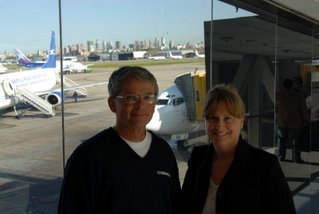
Doug and Rhonda

Jen & Jasmine
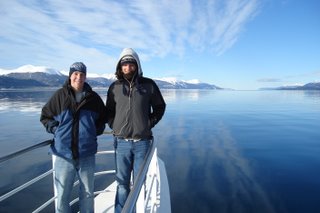
Andy and Jordan

Kat

Zach

Daniel

Tiffany and Jamie

Aaron and Liza

Erica
Friday, November 10, 2006
STREET MEAT
"Watch for the places where the taxi drivers congregate." This was the advice we were given regarding street vendors who daily set up their grills and offer up chorizos, hamburguesas y bife sandwiches. So, on the first walk from the Casa to classes at Universidad Catolica Argentina, http://www.uca.edu.ar/, I noted the taxis gathering at a spot near the UCA Agricultural Campus building. It was not too long before many of the students and I became 'regulars' at street meat - a nice sized choripan for two pesos, or about 65 cents - best deal in town!
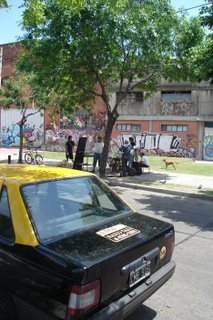
You can see that I did not sneak up on Hugo! When I got closer, he jokingly started singing the Star Spangled Banner and wondered if I was going to send his picture to Bush! Te gusta Bush is a fairly common question here, and I will spare you my spanglish response and a political rant!

Here is Hugo at the grill. My first class at UCA is at 9:00, and Hugo is usually at his spot awaiting the delivery of his grill and all of the fixings. He has his charcoal grill fired up with meat ready to serve by around 11:00, and generally closes down by 1:30 or thereabouts. He has a couple of choices of bread and sauces including a mild salsa, chimichuri, mustard and mayonaisse. Since our arrival in Buenos Aires, Hugo has added some facturas, breakfast pastries, to his 'menu.' His amigo Gabriel helps with drinks and odds and ends. I have to wonder if Gabriel is an apprentice, looking to open up his own operation some time!

Hugo and Gabriel - Kings of Street Meat
Monday, November 06, 2006
OPERA PAMPA
I am still bummed about not having our camera. And, I just learned that the fine print on the Limited Warranty says "US Only." I do believe that a letter to Sony will be forthcoming. So, as a less-than-satisfactory substitute for personal pictures, take a tour through http://www.operapampa.com.ar/ Last Thursday nights group dinner was at Opera Pampa, which is not so much an opera, but a grand outdoor venue show about Argentine history and culture. There was a pre-show reception, the well-presented show with singing, dancing and horsemanship, and an after-show asado. There is an interesting side-story regarding a person who was a guest of several of our students - the following is lifted directly from Stacey Gallarde's blog on her Junior Year Abroad website - www.nbc4.tv/jya
Boy do I have a story to tell.
Two of my friends and I had lunch with an American actress this weekend. Yes, in Buenos Aires.This is how it happened. So Britney, Stephani and I were at the subte stop just sitting and talking (in English) when a woman walks up to us and asks us (in English) where we were from. Steph says she's from San Jose, and the woman says, "Oh, I'm from LA". Then all three of us tell her that we actually go to school at Pepperdine in Malibu. The woman replies, "I live in Malibu!"
Ok, first off this is crazy enough! Malibu only has a population of roughly 13,000 people. How is it possible its few inhabitants run into each other in Buenos Aires, Argentina?
Two of my friends and I had lunch with an American actress this weekend. Yes, in Buenos Aires.This is how it happened. So Britney, Stephani and I were at the subte stop just sitting and talking (in English) when a woman walks up to us and asks us (in English) where we were from. Steph says she's from San Jose, and the woman says, "Oh, I'm from LA". Then all three of us tell her that we actually go to school at Pepperdine in Malibu. The woman replies, "I live in Malibu!"
Ok, first off this is crazy enough! Malibu only has a population of roughly 13,000 people. How is it possible its few inhabitants run into each other in Buenos Aires, Argentina?
Back to the story. So we get to talking (her name is Jamie) and she tells us where she lives in Malibu, why she's here in Buenos Aires (for tango dancing) and how long (9 days), etc. Anyway, in the end, Jamie takes us under her wing (even calls us her daughters) and goes on our city outing with us. She takes us out to lunch, and during our conversation we find out that she is an actress! Most of her work was done in the 80's because she is now focusing on being an acting teacher. She was on the show Falcon Crest, had her own TV show for awhile, has worked with Clint Eastwood, Billy Bob Thorton, Johnny Depp, and my favorite, The Olsen Twins (Holiday in the Sun)!
Friday, November 03, 2006
TIME FLIES
When you are having fun, eh? Much has transpired since our last entry, including the usual, such as classes, convocations, asados and group dinners, and the very special, including the visit of Arlene Cook from Colorado and a weekend spiritual retreat with the students. Arlene and Rhonda are great friends, having first met while teaching elementary school in Colorado Springs. I don't think that I can recount all of the adventures - the six days went by much too quickly. Rhonda and Arlene were out and about while I was teaching, visiting various barrios and the musuem of fine arts, taking a boat across the Rio de la Plata for a day trip to Colonia, Uruguay, and of course shopping! The three of us were able to enjoy an opera at the Teatro Colon, shopping on Florida, the Recoleta cemetery and nearby street fair, and dinners at places like Siga de Vaca, Forrest Gump, Maru Botana and Kansas. Don't let the norteamericano names fool you - each is distinctly Argentine. We introduced Arlene to subte linea d, bus linea 67, and long walks, and she adapted very quickly. I know that all of the students were delighted to meet Arlene, and that Arlene also appreciated the chance to meet and chat with the students. All-in-all, we had a wonderful time, and we look forward to other family and friends visits to Buenos Aires.
A few words about the spiritual retreat. This is an elective event for the students to spend a bit of time away from the city, to reflect, to re-create, and to re-energize for the remaining month of the fall semester. Over forty students participated. We traveled by bus to the Estancia Ternura, the Tenderness Ranch, which is probably a name that I would not have chosen for a country estate - sounds a bit shady :-) Regardless, the estancia was a great place, with nice accommodations, recreational facilities such as a basketball court, soccer field, pool and spa, and stables. I particularly enjoyed playing some basketball and riding along on the tractor with a farmhand who was mowing a hay field. More importantly, there were times for selah, for singing, and for hearing from the student retreat organizers and from Diego, the weekend resource person.
Friday, October 20, 2006
THIS, THAT AND THE OTHER
A Typical Week - Although it could be said that in an international program, there is no such thing as a typical week, there is a bit of a routine for each week. I teach two classes, and the Human Genetics class meets on Monday, Tuesday and Friday mornings, and the Science and Religion class meets on Tuesday and Friday mornings and Wednesday afternoons. After classes on Wednesday, everyone meets at the Casa for convocation [usually a time of worship songs and a presentation, e.g. the US Ambassador will soon be coming to a convo], and then we all go out for a group dinner. Dinners are at various restaurants and thus far have included Greek with a dance show, Italian with an operetta show, International with a tango show, and Norteamericano with no show - just great food and swift service. Thursdays, I do not have any classes, and there is a noontime asado at the Casa for everyone. On Thursday evenings, volunteers go to a Catholic church facility to prepare sandwiches for the families of hospitalilzed children. There usually are about a dozen students who show up - Rhonda and I help out at the church, and then the students take the food to a hospital and meet with the families, sing songs and play games. Many of the weeks are punctuated with special events, such as sports days with some of the local schools, long weekends for travel time, field trips, and a spiritual retreat that is coming up this Friday through Sunday. When I am not grading homework and tests, or preparing for classes, we try to get out and about to explore the city, visit various barrios and browse at the many ferias. Rhonda has been doing a "good job" of browsing rather than buying :-) She has time for reading, Sudoku, and the internet. She also is 'mother on call' for the 51 students, and is a real heroine when she whips up some homemade dishes and desserts to share with the students and staff. "Mrs. S., you are soooooooo awesome" is a common quote when Rhonda is working in the kitchen.
Cultural Adjustments - Some folks have asked us what we miss, and aside from the obvious such as family and friends, it is not that we are missing a lot, but rather it is getting used to a different way of life. Such as no car. When we left the USA, we got out of the auto market [no insurance payments, no license fees], and here, we get around almost exclusively by walking and riding the subte. This past Sunday, we rode the bus, and last Friday evening, we took a taxi to the Teatro Colon. And, it was not really a 'taxi' but rather was with Andres, a driver who does a lot of hired driving for Pepperdine in Buenos Aires. For example, we hired Andres to take Rhonda to the airport last Thursday to pick up our good friend Arlene Cook from Colorado Springs, and we will probably hire Andres to go to the airport when our kids come to visit. Rhonda recently noted that "riding in a car is like a special treat," although we certainly do not need and indeed do not want a car. One of our car-savvy students notes that there are models here that are not available in the USA, e.g. the Toyota Hilux truck and SUV, the Mercedes 200C and A class, and the Chevrolet Astra, Vectra and Corsa.
One interesting difference that we noted rather quickly was that there are no window or door screens at the Casa, and possibly in all of Argentina! It is great to have everything open for the buenos aires, but it is thus also open to the pests, notably the mosquitoes [totaly random aside, speaking of mosquitoes and 'good air' what disease was named after 'bad air'?]. Another thing that we noted was the large number of stray cats and dogs, and the large number of dogs with owners. All of this makes one very conscious of where one walks on the sidewalks and in the parks. It is also very clear that we are living in a very large city - about one third of the 39 million people in Argentina live in Buenos Aires, or as it was originally known, Ciudad de la Santísima Trinidad y Puerto de Santa María de los Buenos Aires, "City of the Most Holy Trinity and Port of Saint Mary of the Fair Winds." The population of 13,000,000 places Buenos Aires in 12th place among the largest urban areas in the world, and thus there are all of the attendant mega-city characteristics, good and bad - the "Paris of South America" with all of the cultural amenities; street trash and noise around the clock; great public transportation; poverty; and the list goes on as you can imagine.
Skype - Thank goodness for Skype! This free voice-over-internet software makes it possible to talk computer to computer for free, and from our computer to USA phones for 2.1 cents per minute. And, the quality of communication is generally quite good. So, between Skype and the internet, we feel like we are fairly connected to the folks back home. And, of course this blog helps us to connect to those of you who take a moment to read it!! Drop us an email sometime, and buen dia.
Wednesday, October 18, 2006
SONY DIED
Well, the Sony camera is not totally dead, but it is off to the repair shop to see why its screen went blank. Without our camera, we were not able to get any pictures of Mar del Plata, the oceanside city where Rhonda and I spent a very relaxing three day weekend. If you link to http://www.hotellasrocas.com.ar/ you will see where we were and a bit of local scenery. There is a long walkway along the ocean, going past very rocky shores that transition to large beaches. The surf was about 4-5 feet, and there were a fair amount of surfers - no bathers however since the water is still pretty chilly. Mar del Plata is a beach town more like Atlantic City than Malibu, and thus the next time we head to the Atlantic, we will probably search out a small community. Also on the long weekend, the students headed out of town and most of them traveled to Cordoba for Fiesta de las Cervezas, better known to us German-types as Oktoberfest. Their bus rolled back to the Casa at about 5:30 am, and my biology students hastily prepared for their quiz at 9:00!
Since our camera is on the blink, I have added a few more whale pictures from our trip to the Valdes Peninsula. You can see how close to the whales we were at times, and also you can get a glimpse of one whale's tongue and baleen - a sight we were told that is fairly uncommon. And to give proper credit, these four photos were taken by our good friend and colleague Lee Kats who was able to join us for a portion of the educational field trip.
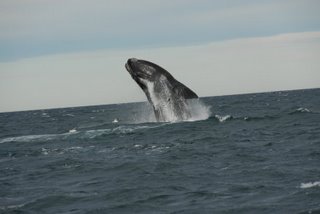

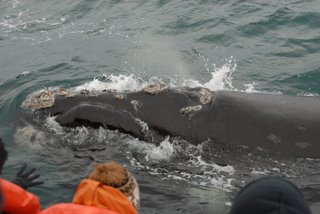

Saturday, October 07, 2006
EAST IS EAST
And West is West, but what about North and South?? I am not sure of the source of my inner desire to know the N-S-E-W orientation of my whereabouts. Maybe it was growing up in Northern Indiana where nearly all of the roads run North-South and East-West, with some notable exceptions like US33 through Goshen to Elkhart, or SR 119 from Goshen to Nappanee, or the county roads that follow the rivers and races like around Bainter Town. Maybe it was living in Colorado where the Front Range is always to the West, or living in New Mexico where the Jemez are to the West and the mountains of Santa Fe and Taos are to the East. Maybe it was living by the ocean where the Santa Monica Mountains are to the North and the Pacific to the South.
But here in Buenos Aires, there are no helpful visual cues - no mountains, no oceans. In our neighborhood of many high rises and big trees, it is often difficult to see the location of the sun. Not that it would help me much since I have to stop and think "It's October, but we are in the Southern Hemisphere which means it's not fall heading to winter, but rather spring heading to summer which means the sun is heading South of E-W rather than North....." Oh, to have those Elkhart County even-numbered roads for a reference that when west-bound at the equinox, the sun was setting right in your eyes, with winter sunsets far to the South of West and summer sunsets, far to the North of West. Also, not being able to see much of the sky means that you cannot tell when 'weather is coming.' For example, in Colorado Springs, it is pretty easy to see what is in store weather-wise.
Of course there do not seem to be any roads here that run straight N-S-E-W. When we go out the front door of the Casa on to 11-de-Septiembre, I have to think "It's kinda South and the road runs kinda East-West" but in actuality, the front door pretty much faces SW, which means the road runs NW-SE. And, to top it all off, many of the maps and guide books do not have North at the top of the map!!! Thankfully, the subte map is "correct" :-)http://urbanrail.net/am/buen/buenos-aires.htm
Sunday, October 01, 2006
MORE PICTURES AND A RECOMMENDATION
Here are several more pictures from our educational field trip - and the recommendation is at the end. I have dubbed the first picture tipo viejo since it really is an old guy. While wandering on an estancia on the Patagonia steppe, Rhonda and I came across this burial box. We later learned that is an aboriginal site, and interestingly, this particular individual was quite tall.

Also at the Patagonia estancia, we were given a demonstration of sheep shearing by one of the local gauchos.
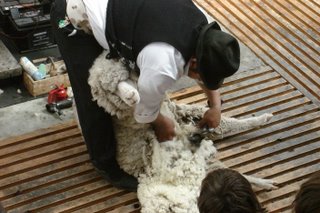
This is one of the many guanacos that we saw in Patagonia. Interestingly, they are also found in Tierra del Fuego, which is an island. The guanaco originally came to the island across the frozen channels and sounds.
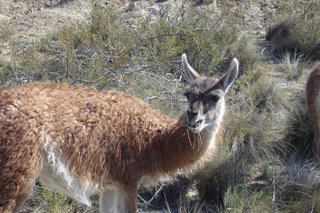 Close to our hotel in Puerto Madryn, we saw this statue of Saint Francis of Paola, who is the patron saint of mariners and boatmen. This was a gift to the city from the people in Paola, Italy.
Close to our hotel in Puerto Madryn, we saw this statue of Saint Francis of Paola, who is the patron saint of mariners and boatmen. This was a gift to the city from the people in Paola, Italy.  And, on our boat cruise on the Beagle Channel in Ushuaia, we were able to get up-close and personal with some of the wildlife, including these seals and cormorants.
And, on our boat cruise on the Beagle Channel in Ushuaia, we were able to get up-close and personal with some of the wildlife, including these seals and cormorants.
And now for the recommendation. Take a moment to visit www.nbc4.tv/jya One of our students, Stacey Gallarde, was chosen from students across the USA to be one of ten who are documenting their junior year abroad. Peruse the page, and then if you click on her image, you will be taken to the page where she has posted several videos, many pictures and a blog.
Tuesday, September 26, 2006
EDUCATIONAL FIELD TRIP - ARGENTINA
EDUCATIONAL FIELD TRIP
FALL - 2006
USHUAIA
After our four days in Puerto Madryn, the Valdes Peninsula and the Patagonia steppe, we flew from Trelew to Ushuaia, Tierra del Fuego, the southernmost city on the continent. There was a marked difference between a semi-arid region of Patagonia to a mountains, lakes and channels region of Patogonia. The first picture is the view from our window at the Los Cauquenes hotel, overlooking the Beagle Channel toward the southern peaks of the Andes.


Our first day was a Lagos Off Road excursion, into the mountains, through the woods and along the shore of one of the many large lakes in Tierra del Fuego. We had an asado at an outpost near the lake, and as we stood around the campfire, we had a visitor! He was very edgy but also very interested in some lunch. Some of the other activities included exploring the downtown area of Ushuaia, a boat cruise on the Beagle Channel, and a day of skiing at Cerro Castor




Friday, September 22, 2006
EDUCATIONAL FIELD TRIP - ARGENTINA
EDUCATIONAL FIELD TRIP
FALL - 2006
THE VALDES PENINSULA
Our week-long field trip began on Wednesday the 13th, and as you can see, the crew was very excited to head out. We flew from Buenos Aires to the Trelew Airport and traveled by bus to the town of Puerto Madryn in the province of Chubut.

The Territorio hotel at sunrise. http://www.hotelterritorio.com.ar/
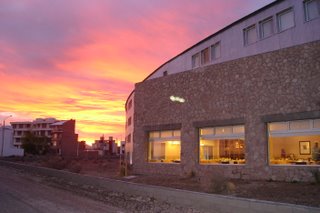
We boarded our buses and headed for the Peninsula village of Puerto Piramides for whale watching on the Golfo Nuevo and then on to Caleta Valdes to see elephant seals. The Valdes Peninsula is a geological extension of the semi-arid Patagonia steppe, and is a World Heritage Reserve with controlled access. There are only a few hundred residents on the peninsula, in a couple of small villages and on several large estancias. I have many pictures, none of which can do justice to the amazing things that we saw and experienced. There will be some spectacular pictures posted on the Pepperdine Buenos Aires website, and I will give the link to that when it is ready. I chose this particular picture because a Southern Wright/Right whale and her young one surfaced right next to our boat. We saw many breaches and wonderful flukes, as literally dozens of whales were within a 1000 yard radius of the boat.
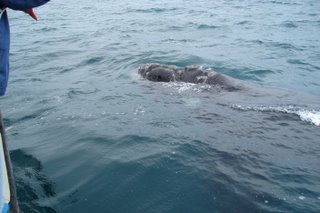
It is the mating and birthing season for most wildlife in this region, and the elephant seals were just beginning to have their pups. Below is the coastline where the orcas come onshore to hunt the seals, and a large male, smaller female and black pup are shown. We had a presentation by the naturalist who has lived among the orcas on the Peninsula, and learned that there are only a handful of orcas that hunt in this fashion, that this behavior is taught to the young members of the clan, and that only a few of the orcas in the clan are the teachers.

At Punta Tombo we had the amazing opportunity to walk among the penguins! These adults are rather small, about 2 feet, and are obviously used to us human-folks. However, if one should happen to get a bit too close, they will quickly let you know that you have crossed the line and are fair game for a powerful peck. I was fortunate to get a short video of one walking in front of us - they have the right of way - and as you can imagine, it is a riot. During the peak of the mating season, which is soon, the population of this penguin colony will be close to 500,000.

Because the steppe is semi arid, there is not a great diversity of animals or plants. There are many guanacos, armadillos, rheas, maras and several rodent species, and a handfull of bird and reptile species. There are about 280 species of plants. However, the gulfs surrounding the Peninsula and the Peninsula shoreline make Valdes a very hospitable habitat for the creatures shown above.
Monday, September 11, 2006
9/11 A VIEW FROM ARGENTINA
It is interesting that the Casa is located on 11 de Septiembre. Naturally folks in the USA think of our September 11, but the Argentine September 11 is to commemorate the passing of nineteenth century President Domingo Sarmiento who was known for his support of education. I am sure that the US media is filled with various perspectives on the day and on the five years since the attacks. What I would like to share is some of the commentary from the Buenos Aires Herald. The Editorial entitiled "9/11" first chided the Argentines and the government for their tepid response to the attacks, but closed with the following paragraph:
"Yet five years later the international response to 9/11 does not look much better - Washington in particular is guilty not so much of oversimplifying the issue (but rather of) the error of confusing conventional warfare against perceived rogue nation-states with effective action against an unconventional and global terrorist challenge. Big Brother methods are also a terrorist victory - rather than fighting fire with fire, the civilized world should retain its faith that the open society and globalization which the terrorists turned to their advantage can also be used against them."
There was also a more detailed op-ed piece entitled "9/11: Five Years On - US Foreign Policy in the Shadow of September 11" from which I have lifted the following quotes that reflect the tenor of the article:
"If anniversaries are good for anything it is as an opportunity for sober reflection and analysis. . .(the attacks gave) a sense of direction and purpose to a Bush administration that previously had defined its foreign policy agenda in largely negative, anti-Clintonian terms. According to the campaign rhetoric of 2000, a Bush-Cheney administration would avoid half-baked humanitarian interventions of the Kosovo and Somalia type and focus instead on rigorous defense of US interests. By September 2001 it remained uncertain what these interests were and what their defense would amount to in practical terms. The rhetoric of democracy promotion and security projection represented a merger of the two dominant schools of post-Cold War US foreign policy thinking. . . In place of Communism, Islamic extremism was now installed as the monolithic, global threat against which the US foreign policy and military apparatus must be aligned. . . Although a fascinating intellectual exercise, the Bush Doctrine has been a mitigated disaster in application. . . Although the Afghanistan and Iraq campaigns have been failures if judged in terms of democracy promotion and security projection, the gradual withdrawal of US forces from Afghanistan even as the country regresses back into chaos suggests that these were never the real priorities of the US invasion. . . The idealistic sounding elements of the Bush doctrine were always secondary to the 'realist' preoccupation of attacking perceived threats to US security. (For example) in Pakistan and Saudi Arabia, the Bush administration has cooperated with and sought to protect compliant autocratic regimes. . . Having turned democracy promotion into such a central rhetorical theme, however, the Bush administration is no longer able to admit publicly that democracy is acceptable only if its outcomes fall within certain proscribed boundaries. . One of the major lessons learned from the September 11 attacks and their aftermath is that democracy cannot be spread around the world at the point of a gun. For this reason, the Afghanistan and Iraq invasions are likely to represent a bloody and regrettable historical tangent rather than a sign of things to come."
Of course, every newspaper has its bias, and my initial impression is that the Herald is influenced by the New York Times, e.g. they publish Times pieces such as Thomas Friedman's recent analysis of Iraq. Some of you may know that Chile also has its 9/11, commemorating the 1973 bloody military coup of Augusto Pinochet toppling elected President Salvador Allende. Pinochet remains secluded and under indictment for human rights abuses and tax evasion.
Sunday, September 10, 2006
STUDENTS ARRIVE!!
Well, the halcyon days at the Casa are over - our 51 ninos arrived on Tuesday morning. The students had the same flights that we had from LA, and thus arrived in Buenos Aires at about 7:30 in the morning. Considering that they had flown all night, and changed planes in Lima, most of them were fairly chipper. The morning air was brisk, which seemed to come as a shock to some - hey, it's winter here! After Luz, Maria and Rafa greeted everyone and checked them in, we boarded two buses for the trip to the Casa. Similar to the busy first day that we had, the students' day was filled with paperwork, orientation, and of course an asado. The real highlight of the day began at 5:00 when the homestay parents started to arrive to pick up their students. It was interesting to watch the level of anxiety rise as the time drew near, and I believe without exception, each student was feeling some apprehension. Many of the students had gone to a nearby vendor to get flowers as a welcome gesture for their new mommas and papas. And, without exception, all anxiousness disappeared as one by one, a host would be brought to the doorway, a student would be called forth, hugs exchanged, suitcases gathered, and the new family would head home. It really was exceptional, and exciting, for us to watch the beginning of what will no doubt be an unforgettable learning experience for each student.
One of the first things that the students have to adjust to is the daily routine of the Argentine families, e.g. dinner at 9:00 pm. The host families provide breakfast and dinner, and the classes are scheduled between 9 am and 6:00 pm. However, our classes do not begin until September 22. Until then, our time will be filled with an orientation tour of the city and our neighborhood, lectures on the history and culture of Argentina, and language 'boot camp' which is intended to get everyone beginning to think and speak Spanish, and to get accustomed to hearing the "zh_" pronunciation for the 'y' and 'll' words - cinco de Mazho (Mayo), Ozheros (Olleros), zho (yo), como se zhama - you get the idea. Thursday and Friday were filled with culture and language classes, and then the weekend - well, you can probably guess where most of the students spent some of their time on the weekend. Buenos Aires is rather noted for the club scene, and I think that most of the kids got introduced to the night life - a different type of culture and language experience! Monday and Tuesday will again be culture and language classes, and then we leave for our fall semester educational field trip to Ushuaia and the Valdez Peninsula.
Rhonda and Doug's weekend time was much more sedate - a run in the park, cafe y postres, riding the subte to different parts of the city to explore the shops, cafes, and mercados pulgas. We were told of a large antique market in San Telmo on Sundays, so we made our way there via subte and foot. We did not know exactly where we were going, but that usually does not stop us - and we indeed found it close to where we thought it would be! It was an impressive experience. It's Sunday evening now, and some of the kids are going to Rey de Reyes for worship, and we will gather here at the Casa with others who wish to spend some time in singing, reflection and prayer.
One of the first things that the students have to adjust to is the daily routine of the Argentine families, e.g. dinner at 9:00 pm. The host families provide breakfast and dinner, and the classes are scheduled between 9 am and 6:00 pm. However, our classes do not begin until September 22. Until then, our time will be filled with an orientation tour of the city and our neighborhood, lectures on the history and culture of Argentina, and language 'boot camp' which is intended to get everyone beginning to think and speak Spanish, and to get accustomed to hearing the "zh_" pronunciation for the 'y' and 'll' words - cinco de Mazho (Mayo), Ozheros (Olleros), zho (yo), como se zhama - you get the idea. Thursday and Friday were filled with culture and language classes, and then the weekend - well, you can probably guess where most of the students spent some of their time on the weekend. Buenos Aires is rather noted for the club scene, and I think that most of the kids got introduced to the night life - a different type of culture and language experience! Monday and Tuesday will again be culture and language classes, and then we leave for our fall semester educational field trip to Ushuaia and the Valdez Peninsula.
Rhonda and Doug's weekend time was much more sedate - a run in the park, cafe y postres, riding the subte to different parts of the city to explore the shops, cafes, and mercados pulgas. We were told of a large antique market in San Telmo on Sundays, so we made our way there via subte and foot. We did not know exactly where we were going, but that usually does not stop us - and we indeed found it close to where we thought it would be! It was an impressive experience. It's Sunday evening now, and some of the kids are going to Rey de Reyes for worship, and we will gather here at the Casa with others who wish to spend some time in singing, reflection and prayer.
Tuesday, September 05, 2006
ESTANCIA LOS PATOS
ESTANCIA LOS PATOS

Casco Estancia Los Patos
As a bon voyage or buen viaje gift, our wonderful colleagues and friends in the Natural Science Division gave us a weekend at an estancia. Among their suggestions was La Estancia Los Patos, so that is where we spent two days. The estancia is about 150 kilometers outside of Buenos Aires, in la pampa or flat land - and indeed it is very flat for hundreds of miles.
 Sra. Lili y Sr. Angel M. de Estrada
Sra. Lili y Sr. Angel M. de EstradaAngel and Lili were our most gracious hosts for the weekend. Since this is neither duck hunting season nor vacation time, we were the only guests at the ranch. Los Patos is a working ranch of approximately 700 acres with several hundred head of cattle, a few sheep and dozens of horses, and two full time gauchos. Guests may work with the cattle and horses, hunt, ride horses, or play polo. We enjoyed wonderful meals including an asado, went horseback riding, read by the fireplace, and went walking at the estancia and in the nearby village of Monte.

Monte de Alamos
On our ride, we covered much of the ranch and saw many young calves and a fair number of very-expectant mamas. We also rode through a large stand of poplars that Angel had very meticulously planted in a matrix like the Amish plant corn. Virtually all of the trees in las pampas have been planted. And, as the name of the estancia conveys, we saw hundreds if not thousands of ducks of various types.

Rhonda y Chueco
Those of you who know Rhonda no doubt remember that she has an affinity for dogs - an understatement! So, the dog-of-the-ranch and Rhonda hit it off right away. The owners call him chueco which we learned means pigeon toed. And Cheuco certainly is - Angel said that he was even more so when he was a little pup. You may read more about the estancia at:
Monday, September 04, 2006
CASA HOLDEN
Here are two pictures of our apartment at Casa Holden - looking into the apartment from the hallway, into the sitting room which leads to the bedroom and bath. The sitting room ceiling is a very high dome with a lovely skylight. There is a balcony off of the sitting room, and the second picture is looking out to the balcony.
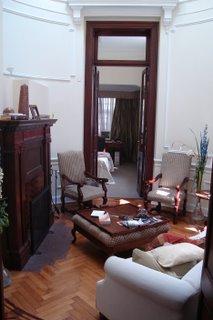
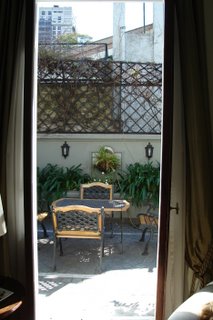
And, as I had previously mentioned, directly across the street from the Casa is Maru Botana!!



And, as I had previously mentioned, directly across the street from the Casa is Maru Botana!!

Subscribe to:
Posts (Atom)
 Andy & Amigo
Andy & Amigo


 Stephani and Britney
Stephani and Britney


